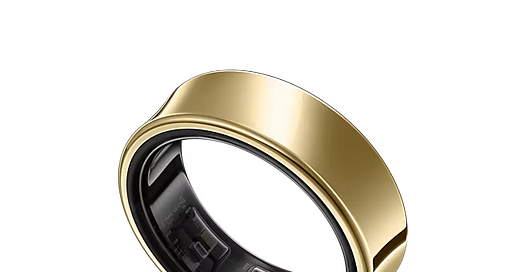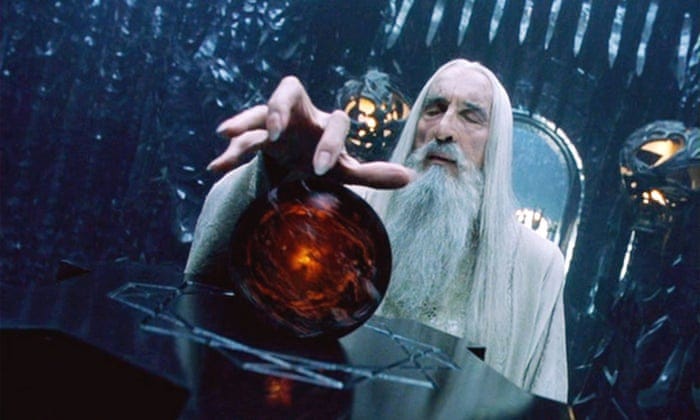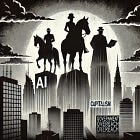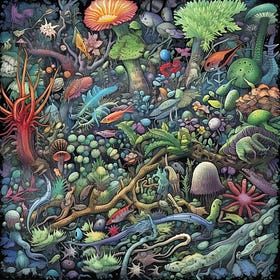Would Samsung’s Smart Ring Make You Say 'I Do'?
Rings are powerful in that they establish identity, authority and commitment. Now they sense changes in your body so deeply that soon we may all be wearing them in unholy matrimony.
"The Eye was rimmed with fire, but was itself glazed, yellow as a cat's, watchful and intent, and the black slit of its pupil opened on a pit, a window into nothing."
- J.R.R. Tolkien, The Fellowship of the Ring
The Galaxy Ring is here, as of July 2024. Doesn’t the gold version remind you of a famous ring from a book series and its film adaptation? What if I told you the wearer would be observed by a far-seeing eye— the creator of the ring— whenever they put it on?
The ring can last up to seven days on a single charge. With but three sensors, it’s able to track everything from snoring to sleeping stages to fertility cycles. It captures heart rate, blood pressure and skin temperature. Not to mention it can take a photo with a connected device. Ready with half a million units, Samsung shows confidence in the sales of this shiny trinket.
Putting technology into fashion and wearables changes us as a society. The medium, after all, is the message. Since the first ring was forged or braided, it has come with a sense of commitment, identification, and power. Rings symbolize human relationships in marriage, social status, or allegiance to a group. Signet rings were used to seal important documents, signifying authenticity and ownership. In many religious ceremonies, rings are central and often referenced in spiritual texts. These smart rings then forge another interesting link between AI and religion that I wish I had included in my letter from earlier this year.
Big tech—with its all-seeing eye—will be able to observe those who wear the One Ring. It seeks to return to its master, bringing data back with it. In some way, when we wear the ring, we are owned by Samsung, marrying their brand, and offering up the precious. That is the precious data collected from our bodies. To be clear, the Galaxy Ring is not some artefact of evil. Rather, as Tolkien framed it, the potential for corruption exists in the hearts of people. The Galaxy Ring, as well as AI, smartphones and the Internet in general, are like the One Ring in the sense that they bring forth a seductive, corrupting force.
Speaking of Lord of the Rings references, the tech start-up Palantir is named after a seeing stone that’s also used by the dark lord. The company offers AI and data analytics for military deployment. Real life and fantasy are, these days, conflated.
"Any sufficiently advanced technology is indistinguishable from magic."
- Arthur C. Clarke
Now we are all lost in our Magic Mirrors, fitting in our pockets and extending. We’ll be wearing rings and jewelry that communes with the Aether. Not to mention the Homunculi tirelessly working inside these devices in order to make our gadgets communicate.
In medieval times, the Homunculus was created through alchemy. Paracelsus, in De natura rerum (1537) outlines his method for creating Homunculi:
That the sperm of a man be putrefied by itself in a sealed cucurbit for forty days with the highest degree of putrefaction in a horse's womb, "venter equinus", meaning "warm, fermenting horse dung" or at least so long that it comes to life and moves itself, and stirs, which is easily observed. After this time, it will look somewhat like a man, but transparent, without a body.
These Homunculi, the “dwarves in the flask”, might be escaping their flasks and appearing neither where we expect nor want them to be.
Perhaps science fiction may be a more fitting comparison. We are cyborgs: our senses extend into the machines that we stare into. We become what we think about. Drowning in our own reflections, we are like Narcissus.
“With the arrival of electric technology, man extended, or set outside himself, a live model of the central nervous system itself. To the degree that this is so, it is a development that suggests a desperate and suicidal autoamputation, as if the central nervous system could no longer depend on the physical organs to be protective buffers against the slings and arrows of outrageous mechanism.”
- Marshall McLuhan
The smart ring is not all doom and gloom. From a public health perspective, the Galaxy Ring could play a crucial role in preventive care. By providing continuous health monitoring, it enables users to keep track of their well-being and potentially identify health issues early. It also somewhat offers a way to make smartphone addiction less of a problem, since it requires no screen.
Yet such advanced health-tracking wearables are alarming to security and privacy. Big tech, with its far-reaching surveillance and impact on our daily lives, is made up of a worrying cabal of start-ups. Partnerships with the government may use such information for surveillance and political advertising.
The continuous monitoring of health data, in a person, will end up affecting their insurance, in the not-too-distant future. People could be denied coverage based on predictions, or have their privacy breached as the data gets shared or exploited by unauthorized parties. Moreover, the integration of these devices into healthcare and everyday life could reinforce corporate influence, particularly from US-based tech giants who shape global regulations and escalating surveillance capitalism. As these technologies evolve, they will face scrutiny from regulatory bodies like the FDA, ensuring they meet rigorous safety and efficacy standards, and must navigate complex legal landscapes, including HIPAA and potential AI regulations in the EU.
Just as the minerals required to make, sustain, and provide cloud services to these smart rings demand the extraction of precious metals and gemstones, so too do they demand a heavy toll on our environment. Mining activities lead to deforestation, soil erosion, and the pollution of water bodies. Technology escalates this consumption, further fueling the demand for conflict minerals essential for infrastructure. The term “conflict mineral,” whether referring to the diamonds used in rings of old or the new chips in smart rings, is a euphemism. What it truly signifies is the violent exploitation and human suffering embedded in these supply chains.
As Noam Chomsky has often pointed out, the global economic system perpetuates and exacerbates these conflicts by prioritizing profit over human lives and environmental sustainability. The extraction of these resources is not just about securing materials but also about exerting control and maintaining dominance. This system disregards the human cost, often turning a blind eye to the exploitation of labor and the severe consequences for those in resource-rich but economically impoverished regions.
Accompanying this are unaddressed issues of unfair labor practices, deeply intertwined with the broader sustainability challenges that large corporations continue to ignore. The rhetoric of sustainability and corporate responsibility often masks the reality of exploitation and environmental degradation, perpetuating a cycle of injustice under the guise of progress.
To avoid an uprising of the Ents, we need sustainable and ethical AI, before these smart rings become popular and far-reaching.
Read on to learn more about tech, nature and culture…
Rings and smartphones are great at keeping track of our health , but what about gut bacteria?
Enhance Your Gut Feeling with Bacteria (Part 1)
While it’s tempting to dismiss all bacteria as being equally unremarkable, some are worth closer examination. Various types have unique powers yet to be harnessed by science. This can generate electrical currents, clean up pollutants, and provide useful signals that could be used as a kind of data logging or measurement device.
Phones are smart, rings are smart, and so are electric cars, except the massive environmental risks the current ways of production bring with them.
Self-Driving Cars Have A Long Road Ahead (Part 1)
Of all the road accidents today, a significant number are due to people making mistakes. Our fellow human drivers are one of the biggest threats to our safety. In the US alone there were over one and a half a million crashes resulting in injuries in 2020. Across the world, there are per year over one million car accidents ending in fatality. Self-drivin…
In general, biology and AI are making for a fascinating and worrying intersection, so their applications are best directed towards sustainability use-cases.














